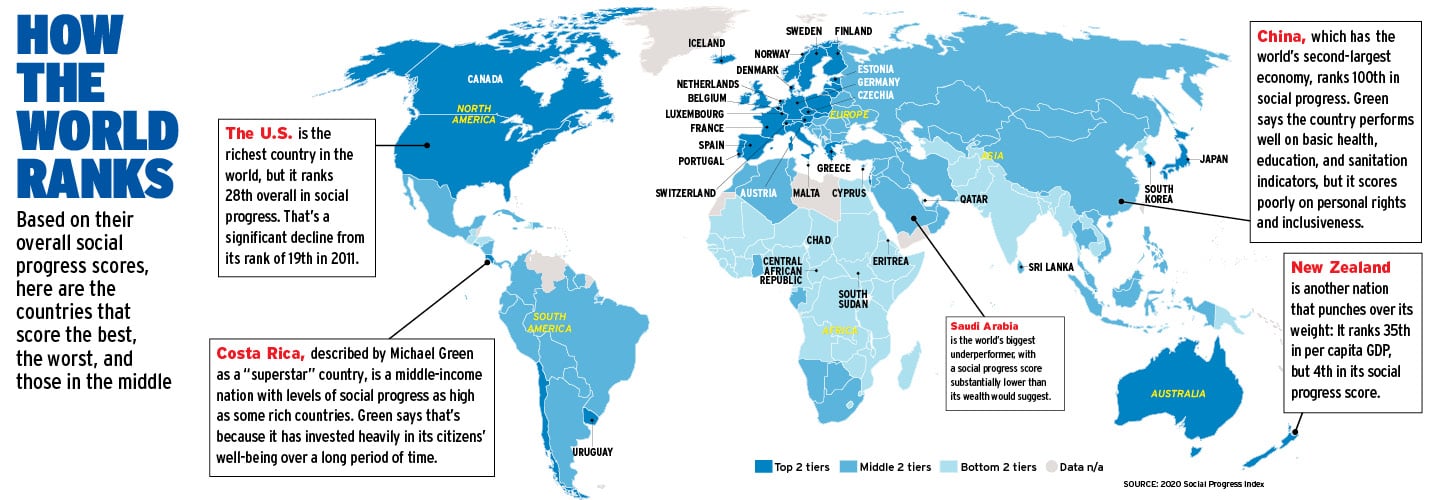Map: Jim McMahon
Map: Jim McMahon
What’s Our Quality of Life?
How does the U.S. stack up against other nations in education, health care, individual rights, and other measures of well-being?

Map: Jim McMahon
Map: Jim McMahon
For almost a century, the world has relied mostly on GDP* as a way to assess a country’s progress and compare it to other nations. But about 10 years ago, a group of economists from the United Kingdom, United States, and other nations created a different way to judge nations’ success: a social progress index.
The idea was pretty simple, explains Michael Green, who leads the project. “Let’s measure people’s real lived experience, based on the real things that matter to real people,” Green says. “Am I living in a good society where everyone has enough to eat, everyone is safe, everyone gets a decent education?”
The index collects 50 metrics of well-being—nutrition, safety, freedom, the environment, health, education, and more—to measure quality of life. Norway comes out on top in 2020, followed by Denmark, Finland, and New Zealand. South Sudan is at the bottom, with Chad, Central African Republic, and Eritrea just behind. The U.S. ranks 28th, still toward the top of the 163-country list, but behind significantly poorer countries such as Estonia, Czechia, Cyprus, and Greece.
“The data paint an alarming picture of the state of our nation,” says Michael Porter, a professor at Harvard Business School, about U.S. scores overall, though the U.S. does very well in some categories, such as higher education and access to electricity.
There’s a lot of reason for optimism in the 2020 report, though. Of the 163 countries evaluated this year, 155 have improved their scores in the past decade.
“We also see that GDP isn’t destiny,” Green says. “At any level of GDP, some countries are better at turning their wealth into social progress than others.”
The world has long used GDP* as a key way to assess a country’s progress and compare it to other nations. In fact, GDP has been used for almost a century. But about 10 years ago, things began to shift. A group of economists from the United Kingdom, United States, and other nations teamed up to explore new options. They worked together to create a different way to judge nations’ success. This new ranking system is called a social progress index.
The idea was pretty simple, explains Michael Green, who leads the project. “Let’s measure people’s real lived experience, based on the real things that matter to real people,” Green says. “Am I living in a good society where everyone has enough to eat, everyone is safe, everyone gets a decent education?”
The index collects 50 metrics of well-being to measure quality of life. The indicators include nutrition, safety, freedom, the environment, health, education, and more. Norway comes out on top in 2020, followed by Denmark, Finland, and New Zealand. South Sudan is at the bottom, with Chad, Central African Republic, and Eritrea just behind. The U.S. ranks 28th. That puts the U.S. toward the top of the 163-country list. But the U.S. is still behind poorer countries, such as Estonia, Czechia, Cyprus, and Greece.
The U.S. does very well in some categories, such as higher education and access to electricity. But the U.S. scores overall tell a different story. “The data paint an alarming picture of the state of our nation,” says Michael Porter, a professor at Harvard Business School.
There’s a lot of reason for optimism in the 2020 report, though. Of the 163 countries evaluated this year, 155 have improved their scores in the past decade.
“We also see that GDP isn’t destiny,” Green says. “At any level of GDP, some countries are better at turning their wealth into social progress than others.”
*Gross Domestic Product; a measure of a country’s economic output
*Gross Domestic Product; a measure of a country’s economic output
Environmental Quality
The countries with the overall cleanest air and lowest levels of greenhouse gas emissions
The countries with the overall cleanest air and lowest levels of greenhouse gas emissions
Lukas Bischoff Photograph/Shutterstock.com
Tallinn, Estonia: the city center
1. Estonia (above)
2. New Zealand
3. Portugal
4. Norway
5. Luxembourg
6. Iceland
7. Finland
8. Spain
9. Sri Lanka
10. France
(U.S. ranks 100th)
1. Estonia (above)
2. New Zealand
3. Portugal
4. Norway
5. Luxembourg
6. Iceland
7. Finland
8. Spain
9. Sri Lanka
10. France
(U.S. ranks 100th)
Access to Quality Health Care
Countries that do the best job providing reliable medical services
Countries that do the best job providing reliable medical services
Marketa Bendova/Alamy Stock Photo
A doctor in Prague, Czechia
1. Czechia (above)
2. Japan
3. Austria
4. France
5. Cyprus
6. Germany
7. Netherlands
8. Qatar
9. Malta
10. Norway
(U.S. ranks 91st)
1. Czechia (above)
2. Japan
3. Austria
4. France
5. Cyprus
6. Germany
7. Netherlands
8. Qatar
9. Malta
10. Norway
(U.S. ranks 91st)
Access to Advanced Education
Where to find the world’s best universities
Where to find the world’s best universities
Timothy A. Clary/AFP via Getty Images
Graduation at Columbia University, New York
1. United States (above)
2. Australia
3. South Korea
4. Netherlands
5. Germany
6. Finland
7. Greece
8. Denmark
9. Norway
10. Canada
1. United States (above)
2. Australia
3. South Korea
4. Netherlands
5. Germany
6. Finland
7. Greece
8. Denmark
9. Norway
10. Canada
Personal Rights
Countries that do the best job protecting their citizens’ rights
Countries that do the best job protecting their citizens’ rights
Marian Weyo/Shutterstock.com
1. Sweden (above)
2. Germany
3. New Zealand
4. Australia & Switzerland
6. Denmark
7. Belgium
8. Netherlands
9. Portugal
10. Uruguay
(U.S. ranks 35th)
1. Sweden (above)
2. Germany
3. New Zealand
4. Australia & Switzerland
6. Denmark
7. Belgium
8. Netherlands
9. Portugal
10. Uruguay
(U.S. ranks 35th)